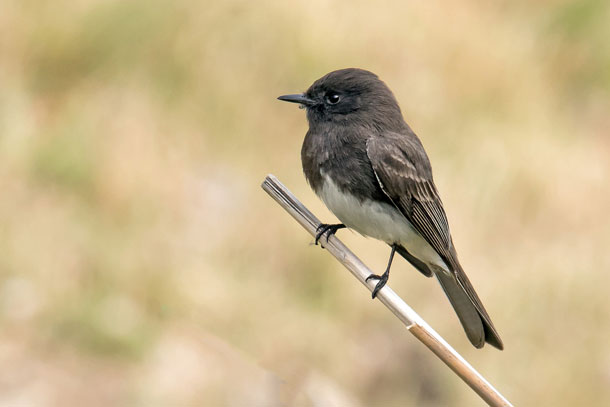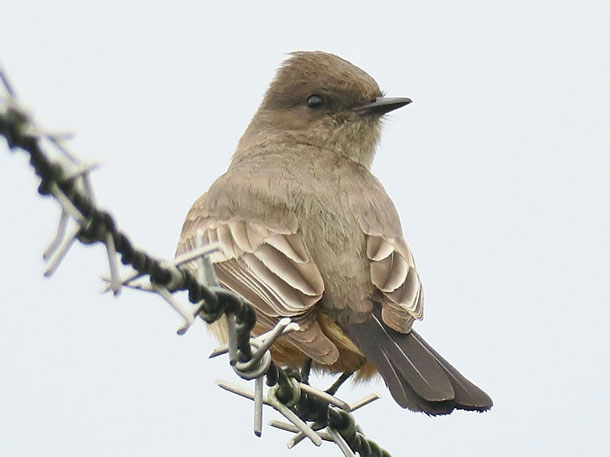Birdnote®: Two Phoebes Share The American West
Air Date: Week of November 2, 2018

A Black Phoebe. (Photo: © Mick Thompson)
In the arid American West, water resources tend to determine where animals and plants can thrive. And while many species need lots of water, others are fine even in the driest desert. BirdNote®’s Michael Stein tells a tale of two phoebes that evolved to occupy different habitats within the same expansive country.
Transcript
[BIRDNOTE THEME]
CURWOOD: In the arid American West, water resources tend to determine where animals and plants can thrive. And while many species need lots of water, others are fine even in the driest desert. BirdNote®’s Michael Stein tells a tale of two phoebes.
STEIN: In the American West, there are two species of phoebe that share the same expansive country. They’re both flycatchers, but they rarely compete for food because they’ve evolved to occupy different habitats.
[Say’s Phoebe song, http://macaulaylibrary.org/audio/191105, 0.12-16]
The Say’s Phoebe’s voice echoes off the rocks of almost any dry canyon west of the Rockies.
[Say’s Phoebe song, http://macaulaylibrary.org/audio/191105, 0.12-16]
A small brown flycatcher with an orange belly, the Say’s Phoebe is named for Thomas Say, an early 19th Century explorer and naturalist. It prefers dry, open habitats ranging from tundra to desert — usually well away from trees or water. It’s just as happy nesting among stone carvings in an Aztec ruin in central Mexico as it is on a cliff face north of the Arctic Circle. No other North American flycatcher ranges nearly so far north.

A Say’s Phoebe perched on barbed wire. (Photo: © Mike Hamilton)
[Say’s Phoebe song, http://macaulaylibrary.org/audio/191105, 0.12-16]
[Black Phoebe song,http://macaulaylibrary.org/audio/126464, 0.08-.11]
The Black Phoebe is a close cousin to the Say’s. But it’s nearly always hunting by a body of water. You’ll find it alongside creeks, reservoirs, or even the tiniest pond in a backyard or garden.
Their voices set them apart, too. The brisk phrases of the Black Phoebe’s song
[Black Phoebe song, http://macaulaylibrary.org/audio/126464, 0.08-.11]
…standing in a sharp contrast to the plaintive refrain of the Say’s Phoebe, with which it shares the American West.
I’m Michael Stein.
[Say’s Phoebe song, http://macaulaylibrary.org/audio/191105, 0.12-16]
Written by Bob Sundstrom
Bird sounds provided by The Macaulay Library of Natural Sounds at the Cornell Lab of Ornithology, Ithaca, New York. Say’s Phoebe [191105] recorded by W L Hershberger; Black Phoebe [126464] recorded by Thomas G Sander
BirdNote's theme music was composed and played by Nancy Rumbel and John Kessler.
Producer: John Kessler
Executive Producer: Dominic Black
© 2018 Tune In to Nature.org October 2018 Narrator: Michael Stein
https://www.birdnote.org/show/two-phoebes-share-west
CURWOOD: For photos, flit on over to our website, LOE.org.
Links
This story on the BirdNote® Website
Living on Earth wants to hear from you!
Living on Earth
62 Calef Highway, Suite 212
Lee, NH 03861
Telephone: 617-287-4121
E-mail: comments@loe.org
Newsletter [Click here]
Donate to Living on Earth!
Living on Earth is an independent media program and relies entirely on contributions from listeners and institutions supporting public service. Please donate now to preserve an independent environmental voice.
NewsletterLiving on Earth offers a weekly delivery of the show's rundown to your mailbox. Sign up for our newsletter today!
 Sailors For The Sea: Be the change you want to sea.
Sailors For The Sea: Be the change you want to sea.
 The Grantham Foundation for the Protection of the Environment: Committed to protecting and improving the health of the global environment.
The Grantham Foundation for the Protection of the Environment: Committed to protecting and improving the health of the global environment.
 Contribute to Living on Earth and receive, as our gift to you, an archival print of one of Mark Seth Lender's extraordinary wildlife photographs. Follow the link to see Mark's current collection of photographs.
Contribute to Living on Earth and receive, as our gift to you, an archival print of one of Mark Seth Lender's extraordinary wildlife photographs. Follow the link to see Mark's current collection of photographs.
 Buy a signed copy of Mark Seth Lender's book Smeagull the Seagull & support Living on Earth
Buy a signed copy of Mark Seth Lender's book Smeagull the Seagull & support Living on Earth

